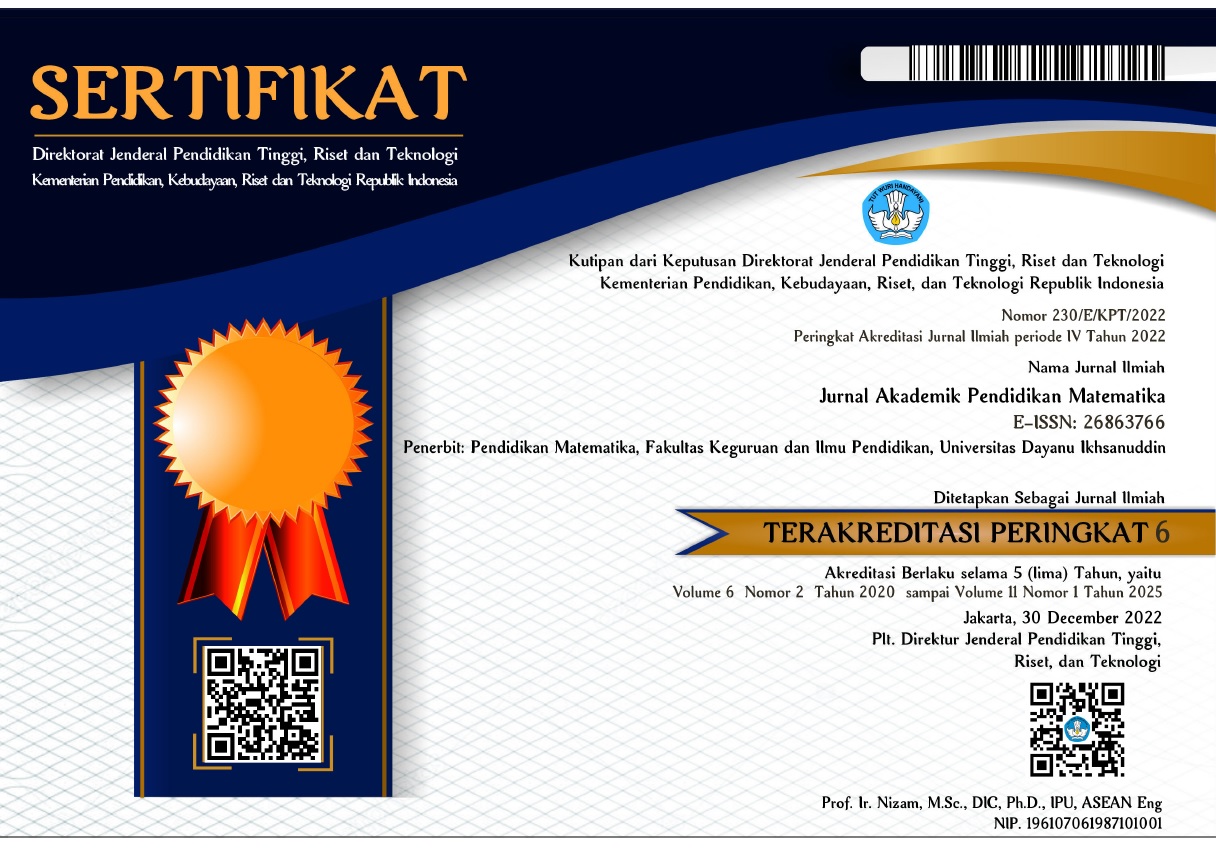Assignment Methods Accompanied by Feedback on Students' Mathematics Learning Outcomes in Solving Integer Operation Problems
DOI:
https://doi.org/10.55340/japm.v7i2.471Keywords:
assignment methods, feedback, mathematics learning outcomes, integer operationsAbstract
The purpose of this study was to determine the difference in the average learning outcomes of students who were taught the assignment method with feedback and those taught the assignment method without feedback in solving integer operations for class VII students of SMP Negeri 7 Baubau. This research is a quasi-experimental research (quasy experimental) with a quantitative approach. The population used in this study were all Grade VII students of SMP Negeri 7 Baubau who were spread in 3 parallel classes with a total of 93 people. To determine which class is the experimental class and the control class, the three classes are drawn by lot. Selected as the experimental class is class VII B and class VII A as control class. This research was conducted in the odd semester of the 2019/2020 school year. The instrument in this study was a test of mathematics learning outcomes. Data were analyzed by prerequisite test which consisted of normality test and data homogeneity test. The results showed that there was a difference in the average learning outcomes of students who were taught the assignment method with feedback and those taught the assignment method without feedback in solving integer operations for class VII students of SMP Negeri 7 Baubau. This is indicated by the value of t_count = 4.310 and the value of sig. (2-tailed) 0.000 < 0.05, meaning that H0 is rejected.
Downloads
References
Arikunto, S. (2002). Dasar-Dasar Evaluasi Pendidikan. PT. Rineka Cipta.
Djamarah, S. B., & Aswan, Z. (2006). Strategi Belajar Mengajar (Edisi Revisi). In Jakarta: Rineka Cipta. Rineka Cipta.
Febriandri. (2008). Remediasi Kesalahan Siswa Dalam Menyelesaikan Soal Cerita Operasi Hitung Campuran pada Bilangan Cacah Menggunakan Lembar Kerja Berstruktur (LBK) di Kelas IV SD Negeri 73 Pontianak Barat. Universitas Tanjungpura.
Hamzah. (2005). Sistem Penilaian Terpadu Antara Kuantitaf Dan Kualitatif Dalam Pembelajaran Kalkulus. Depdiknas. http://www.depdiknas.go.id/Jurnal/37/sistempenilaianterpaduantara.html
Nawawi, H., & Hartini, H. (1992). Instrumen Penelitian Bidang Sosial. University Press.
Nopiyardi. (2009). Proses Dan Strategi Penyelesaian Masalah Pecahan Yang Berbentuk Soal Cerita Di Sekolah Dasar. Universitas Tanjungpura.
Poerwadarminta. (1996). Kamus Umum Bahasa Indonesia. Balai Pustaka.
Polla, G. (2001). Buletin Peningkatan Mutu Pendidikan SLTP, Matematika yang Menyenangkan. Pelangi Pendidikan Majalah Ilmiah Kependidikan.
Rahmawati, D. (2004). Upaya Meningkatkan Kemampuan Siswa Kelas 1 SMU Negeri 3 Pontianak Dalam Menyelesaikan Soal Cerita Pertidaksamaan Kuadrat Menggunakan Pembelajaran Problem Solving. Universitas Tanjungpura.
Riduwan. (2004). Metode dan Teknik Menyusun Tesis. In Bandung : Alfabeta. Alfabeta.
Ruseffendi, E. T. (1994). Dasar-dasar penelitian pendidikan dan bidang non-eksakta lainnya. Bandung: Tarsito. https://doi.org/979-8107-93-4
Silverius, S. (1991). Evaluasi Hasil Belajar dan Umpan Balik. Grasindo.
Sugiyono. (2014). Metode Penelitian Pendidikan Pendekatan Kuantitatif, Kualitatif, dan R&D. In Metode Penelitian Pendidikan Pendekatan Kuantitatif, Kualitatif Dan R&D. Alfabeta.
Trihendradi, C. (2012). Step by Step SPSS 20 : Analisis Data Statistik. Andi.



























